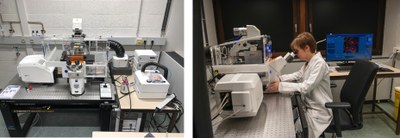Confocal laser scanning microscope Zeis LSM900 Airyscan
Short description
Super resolution confocal laser scanning microscope Zeiss LSM900 Airyscan 2 Multiplex combined with high-speed wide-field.
Applications
This multifunctional microscope allows imaging on fixed and living cells in super resolution confocal mode and in wide-field (epifluorescence) mode, with high speed and sensitivity.
Confocal mode
The Airyscan 2 detector produces confocal images with a XY resolution up to 120 nm (Z resolution: 350 nm). In addition, it allows multiplexing (= acquisition of up-to 4 pixels simultaneously), which enables to reach high-speed confocal scanning (up to approx. 20 images/sec at ~140 nm XY resolution). This detector also provides high sensitivity with low signal-to-noise ratio, which allows gentle imaging with very low laser power and reduced phototoxicity. This device is a powerful tool for multicolor super resolution imaging, dynamic live-cell imaging and 3D reconstruction (from z-stacks). Of note, the software is equipped with modules allowing multiposition acquisition and tile scanning (for large areas).
Wide-field mode
The Colibri light source and the quadband filter allow up to 4-colour fast epifluorescence imaging. The very sensitive sCMOS camera allows gentle imaging of fluorescence and transmitted light over large areas at high speed. This acquisition mode is suitable for experiments that do not require the confocal mode, such as cell migration tracking, or that require faster acquisition (than in confocal mode), such as organelle tracking.
Of note, a deconvolution module will be added soon to produce confocal-quality images from wide-field Z-stack acquisitions. This will make the machine suitable for high-speed 3D imaging (called 3D-deconvolution).
Video 1: 3D imaging of a murine tubule
Proximal tubules were extracted from mouse kidneys and cultured for half a day in a glass-bottom dish coated with fibronectin. Stainings are CellMask™ Orange Plasma membrane Stain (plasma membrane) and NucBlue™ (nuclei), according to manufacturer's recommendations. This preliminary 3D view was acquired on our Zeiss LSM900 confocal equipped with Airyscan system.
Video 2 |
Video 3 |
Video 4 |
| 3D Airyscan images of a human cell portion invaded by intracellular pathogenic bacteria (green), showing swelled mitochondria (magenta). Note that mitochondria are invaded by some bacteria. | 3D Airyscan images of a human cell (HeLa) invaded by intracellular pathogenic bacteria (Shigella, red). Actin cytoskeleton (green) and nucleus (blue) are also shown. Note the formation of actin comets behind bacteria in the cytosol, allowing their motility in the cell. | 3D Airyscan images of living human cells (HeLa) where mitochondria are labeled with Tom20-GFP (green). Note the dynamics of mitochondrial network, with fission and fusion events. |
Technical description
- Inverted Zeiss Axio Observer 7 stand, with fully motorized stage (XYZ)
- Lasers (diodes): 405, 488, 561, 633 nm
- Detectors: 1 Airyscan multi-GaAsp PMT (super resolution) + 2 multi-alkali PMTs
- Objectives: 20x (Plan-Apochromat, NA 0.8, dry), 40x (Plan-Apochromat, NA 1.3, oil), 63x (Plan-Apochromat, NA 1.40, oil, adapted for Airyscan)
- Drift correction: Definite Focus 2
- UV-Vis light source: Colibri 5 with 4 LEDs (385, 475, 555, 630 nm), quadband filter (DAPI, GFP, Cy3, Cy5)
- Camera: sCMOS Photometrics Prime 95B (QE 95%, pixel size 11µm x 11µm)
- Equipped with an incubator box and a stage top CO2/humidity controller (Pecon)
- Antivibration table (compressed air)
Localization
Building 22 (medicine medicine), 4th floor, room 411.
Contact
Academic manager |
Technician |
|
 |
 |
 |
|
Henri-François RENARD |
Catherine DEMAZY |







